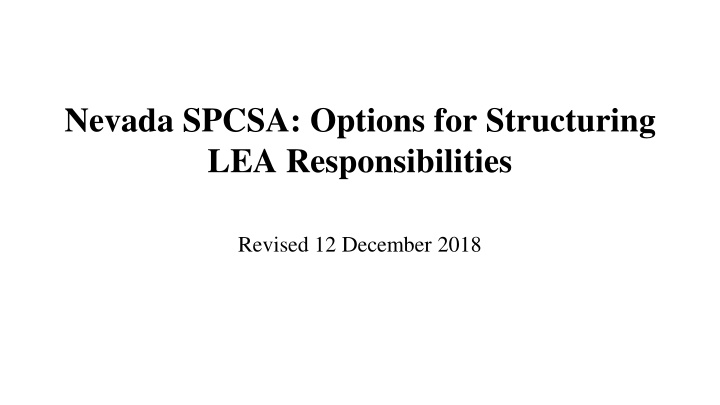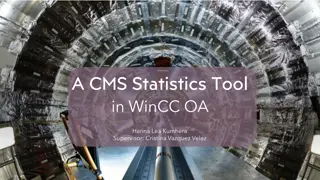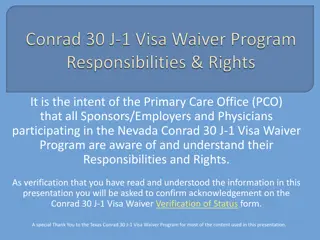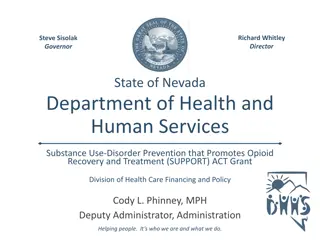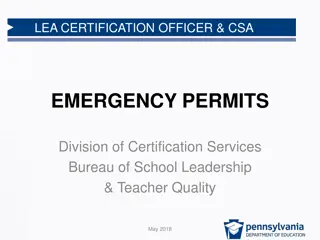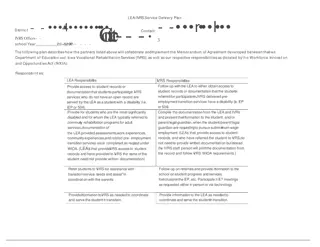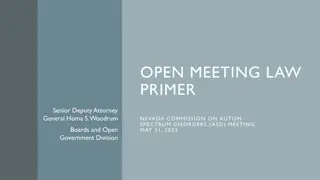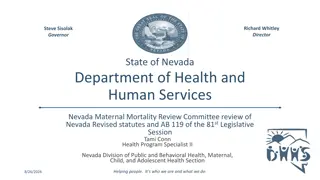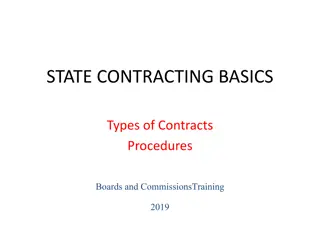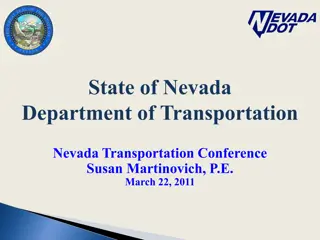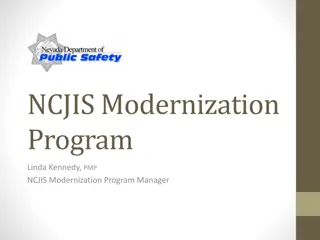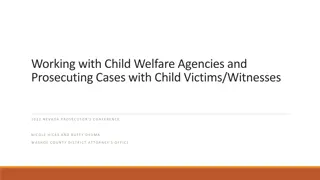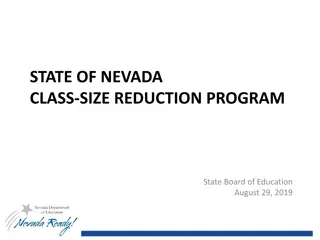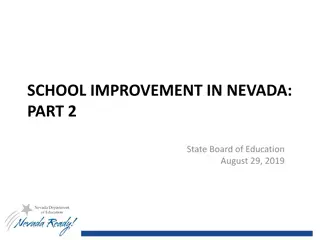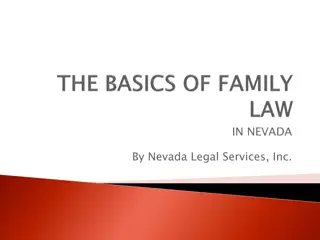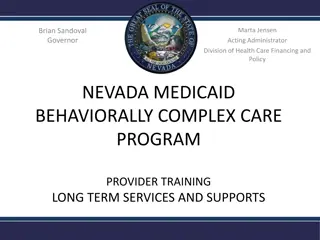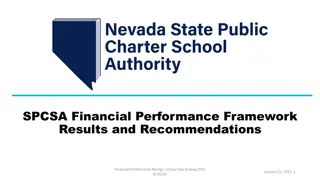Nevada SPCSA Options for Structuring LEA Responsibilities
This presentation outlines the preliminary findings of a project undertaken for the Nevada State Public Charter School Authority to articulate a best-practice service delivery model for charter schools and recommend a process for schools to transition to independent local education agency status. Key activities include reviewing the local context, benchmarking with national peers, and analyzing staffing models. Findings indicate the importance of considering the local context in distributing LEA responsibilities and highlight the capacity building needed for the SPCSA to transition to a full LEA role.
Download Presentation

Please find below an Image/Link to download the presentation.
The content on the website is provided AS IS for your information and personal use only. It may not be sold, licensed, or shared on other websites without obtaining consent from the author.If you encounter any issues during the download, it is possible that the publisher has removed the file from their server.
You are allowed to download the files provided on this website for personal or commercial use, subject to the condition that they are used lawfully. All files are the property of their respective owners.
The content on the website is provided AS IS for your information and personal use only. It may not be sold, licensed, or shared on other websites without obtaining consent from the author.
E N D
Presentation Transcript
Nevada SPCSA: Options for Structuring LEA Responsibilities Revised 12 December 2018
Agenda for Today 1. Review Project Context & Objectives 2. Overview of Objective 1 a. Key Activities b. Key Findings & Exhibits c. Preliminary Recommendations 3. Overview of Objective 2 a. Key Activities b. Key Findings & Exhibits c. Preliminary Recommendations 4. Questions & Discussion
Project Context & Objectives This presentation outlines the preliminary findings from a scope of work that we have undertaken as contractors for the Nevada State Public Charter School Authority. The SPCSA initiated this project at the urging of the Governor s Office and in collaboration with the Nevada Department of Education. Our initial project objectives were to: 1. Articulate a best-practice service delivery model for the SPCSA and NV charter schools, and 2. Recommend a process by which individual SPCSA-sponsored charter schools could qualify for and transition to independent local education agency status.
Objective 1: Key Activities Undertaken Review of local context to understand how SPCSA operates today Review of national landscape to understand how other states have addressed the question of LEA responsibilities Benchmarking exercise with national peers to assess structure, staffing, resources, legal standing, and other factors for the SPCSA Articulation of likely SPCSA responsibilities in the case that SPCSA must serve as the full LEA for its schools; Analysis of SPSCA s proposed staffing model for 2019-20
Objective 1: Key Findings There is no perfect model for distributing LEA responsibilities and, as a result, local context is key to developing a sound plan for Nevada Most national peers do not serve as the full LEA for their authorized charter schools The two organizations that do serve as the full LEA (the South Carolina Public Charter School District and the Colorado Charter Schools Institute) have significantly higher levels of staffing To serve as a full LEA, the SPCSA will need to build significant capacity - in particular, a team of up to six individuals to work with SPCSA schools on matters of special education services and compliance To transition to a full LEA will take time and require significant change management because it will have a material impact on not just the SPCSA but also the charter schools and the NDE
Objective 1: National Peer Staffing & Budget Comparison This staffing comparison demonstrates that the Nevada SPCSA is staffed at low levels compared to the staffing for those statewide authorizers that also serve as a full LEA. The OPSB s LEA office is also included for comparison. Entity Budget Staff Budgeted Campuses Campuses per Staff Budgeted Students Students per FTE NV SPCSA Sponsorship fee of up to 2% but ~1% in practice 17 53 3.11 42,333 2,490 SC PCSD Up to 2% and ~2% in practice 21 39 1.85 25,566 1,000 Colorado CSI Up to 5% and ~2.5% in practice 21 39 1.85 17,500 833 OPSB LEA Office (2018- 19) LEA schools pay an additional 0.25% admin fee (2% instead of 1.75%) plus an LEA chargeback based on actual costs (~$475 per pupil in 2018-19 or ~4.5% of recurring revenue) 30 13 0.43 5,000 (in LEA out of 45,000 total) 167
Objective 1: Preliminary Recommendations In order to achieve success as a full LEA, the SPCSA will need to meaningfully enhance its staffing and may need to undertake significant restructuring activities - for this reason, we recommend: 1. The SPCSA should work in partnership with the NDE according to operationalize full LEA responsibilities over the course of the next two to three years. 2. The SPCSA should be restructured to operate in the long run with two parallel portfolios of charter schools: one portfolio of schools that have achieved independent LEA status, and another that is not eligible for independent status due to capacity, scale, or other considerations.
Objective 2: Key Activities Undertaken Review of SPCSA survey findings regarding LEA transition; Discussion with staff at NDE, SPCSA, a large NV charter school organization, and others Review of national landscape for LEA transitions; Analysis of Orleans Parish School Board (Louisiana) experience with permitting schools to become their own LEA;
Objective 2: Key Findings SPCSA charter schools need the opportunity to learn what it means to serve as their own LEA; Prior to any transition, the SPCSA and the NDE need to reach an explicit agreement on how each party will engage with independent LEA charter schools on questions of support and oversight; The SPCSA may always need to serve as the LEA some of its schools and will need to develop the appropriate structure and staffing to accommodate a mixed portfolio of schools (some but not all as independent LEAs)
Objective 2: Lessons Learned from OPSBs Charter LEA Transitions Questions Lessons Learned How can the SPCSA provide clarity on the distribution of responsibilities between schools, the authorizer, and the State? The authorizer (district) and the charters schools within its LEA need to enter into an explicit contractual agreement (LEA Agreement) that explains the roles and responsibilities of each party. The State is not a party to this agreement for the Orleans Parish School Board but it likely makes sense for Nevada that the NDE participate. How can the SPCSA ensure that staff know how to differentiate the services and oversight they are providing schools? The OPSB established a separate LEA office, specifically structured and staffed to fulfill the LEA service-level agreement. This office operated in parallel to, and separate from, the existing administrative and authorization functions. Some staff within the organization had to be split (e.g. 50/50) between the LEA office and their original function. How can the SPCSA provide appropriately differentiated, adequate, and transparent administrative fees? The OPSB projected a full budget for the LEA function and allocated it on a per pupil basis to determine an LEA fee of approximately $500 per pupil per year that is paid by those schools who are parties to the LEA service-level agreement. This fee is updated on an annual basis as part of the process by which charter schools within OPSB s LEA have the right to seek independent LEA status. While it is difficult to estimate the potential cost for the SPCSA without identifying the specific staffing and services, it is likely that the sponsorship fee would need to increase to at least 2% to cover these supplemental costs. It would likely be appropriate for LEA charter schools would pay a higher administrative fee - potentially much higher - than non-LEA charter schools and this will require segmentation of SPCSA activities and careful cost accounting.
Objective 2: Roadmap to Prepare for Charter LEA Transitions Issue Questions Need Building Capacity How will the SPCSA and the NDE collaborate to provide SPSCSA charter schools with training and development regarding the LEA functions they would need to fulfill if they became independent LEAs? Roles & Responsibilities Training Plan Calendar of PD How will the NDE augment its staffing, structure, and/or strategies to accommodate independent LEA status for SPSCSA schools? Analysis of work independent LEAs will require Assessing Readiness What are the decision rights between the SPCSA and the NDE in determining whether SPCSA schools are permitted to become (and remain) independent LEAs? Decision rights document What are the details of the application process for SPCSA schools and the decision process for reviewing requests? Application, timeline and process Transparent rubric Ensuring Success How will the SPCSA and NDE to collaborate in providing post-transition oversight to SPCSA charter schools that become their own LEA? MOU between NDE and SPCSA What must be changed in policy/regulation to accommodate the existence of independent LEA SPCSA charter schools? List of policy and regulation changes
Objective 2: Preliminary Recommendations We recommend that the SPCSA work with the NDE to develop a process according to which all current SPCSA schools have an opportunity to learn about independent LEA status, receive topical professional development and technical assistance, demonstrate the capacity to serve as their own LEA, and transition to independent LEA status no earlier than the 2021-22 academic year. We recommend that the SPCSA defer to the NDE as to what is an appropriate volume of independent LEA transitions to undergo each year; given the work associated with creating and overseeing a new LEA, it could be that it is best to limit LEA transitions to only a few organizations per year.
Questions & Discussion 1. What initial questions do you have? 2. Where would you like to drill down and review supporting documentation? 3. What would you like us to explore further?
